This is a Leicaflex, a 35mm SLR produced by Ernst Leitz Wetzlar between 1964 and 1968. It was the first in a series of Leicaflex SLRs that were produced through 1976 using the company’s all new Leica R bayonet lens mount that would continue with the Leica R series through 2009. The Leicaflex was Leitz’s first attempt to stray away from their successful rangefinder business into the SLR market. As they had done with their rangefinder cameras, the Leitz spared no expense in building the highest quality camera they could. The Leicaflex was a top of the line camera that sacrificed cutting edge technology for quality. Although the cameras were incredibly well built they were also incredibly expensive, causing Leitz to lose money on every one sold. This resulted in Leitz having to partner with Minolta to build their later R-series in an effort to keep costs down.
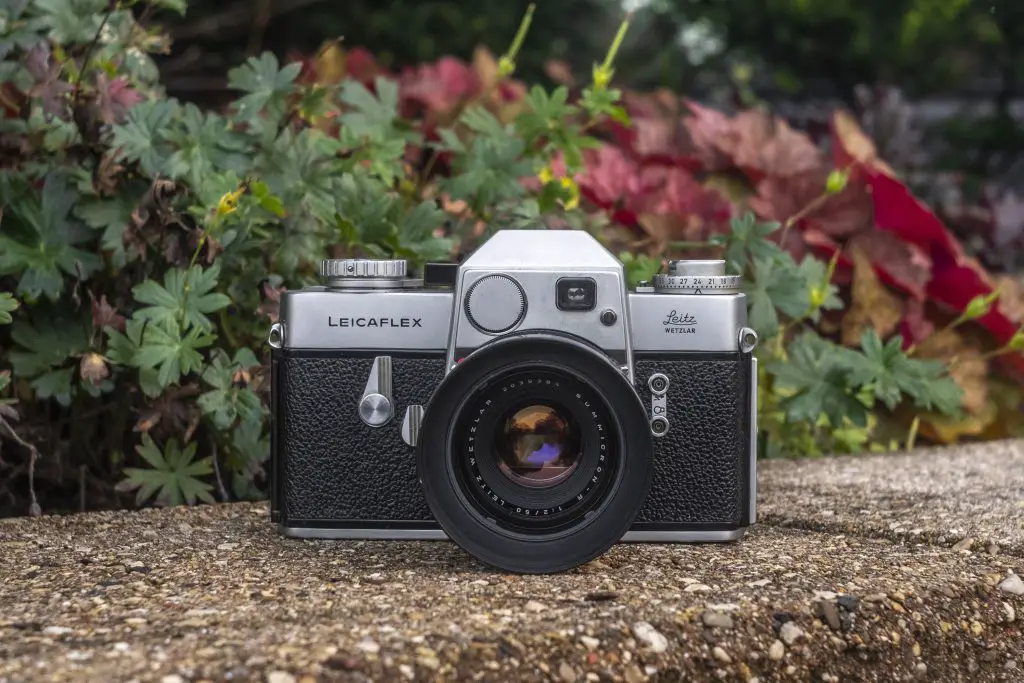 Film Type: 135 (35mm)
Film Type: 135 (35mm)
Lens: 50mm f/2 Leitz Wetzlar Summicron-R coated 6-elements
Lens Mount: Leica R Bayonet
Focus: 20 inches to Infinity
Viewfinder: Fixed SLR Pentaprism w/ Shutter Speed and Match Needle Displays
Shutter: Cloth Focal Plane
Speeds: B, 1 – 1/2000 seconds
Exposure Meter: Coupled CdS Cell
Battery: 1.35v PX625 Mercury Battery
Flash Mount: Coldshoe and M and X Flash Sync
Weight: 1144 grams (w/ lens), 833 grams (body only)
Manual: https://www.cameramanuals.org/leica_pdf/leicaflex.pdf
Sales Brochure: https://www.pacificrimcamera.com/rl/01193/01193.pdf
How these ratings work |
Despite being Leitz’s first attempt at making an SLR, they spared no expense in quality. These cameras are incredibly smooth in operation and have some of the finest lenses ever made for any camera. The viewfinder is amazingly bright, as bright as any camera that would come decades later. The number one criticism of this camera is it’s lack of a TTL meter, but in use, this was hardly an obstacle for me. The meter on this example was accurate, and the match needle system worked fine. These are expensive cameras for a reason, because they’re worth it! | ||||||
| Images | Handling | Features | Viewfinder | Feel & Beauty | History | Age | |
| 2 | 2 | 1 | 2 | 2 | 2 | 20% | |
| Bonus | +1 for build quality excellence and one of the best viewfinders I’ve ever seen | ||||||
| Final Score | 14.2 | ||||||
History
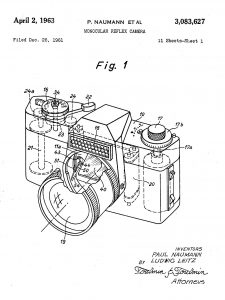
Harley Davidson makes motorcycles, Nintendo makes video games, Gibson makes guitars, and Leitz makes 35mm rangefinder cameras. Or so we thought.
There are certain companies that you associate a very specific product from and since the first Leica camera went on sale in the 1920s, that was what people expected. Yet by the late 1950s, as Single Lens Reflex cameras increasingly ate away at the sales of rangefinder cameras, many people asked the question, “When will there be a Leica SLR?”
The world would get it’s answer in 1964 with the release of the Leicaflex, Ernst Leitz’s first SLR camera. In development for at least 3 years (some sources suggest 8 years, but I doubt that), the Leicaflex compared to the Leica M3 in build quality, making no compromise on materials and tolerances, but in every other way, was a completely new camera.
The first evidence of the Leicaflex’s creation is from a patent filed with the US Patent office dated December 1961 as the Monocular Reflex Camera. Credited to Paul Naumann and Ludwig Leitz who was also responsible for the Leica M3’s rangefinder, the camera hints at the design of what would become the Leicaflex. Although just a drawing, we can see the biggest difference is in the presence of a large selenium exposure meter on the front of the pentaprism.
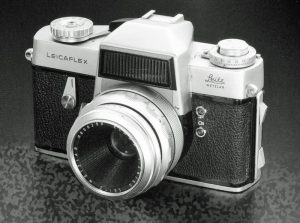
Leitz tried to put as much rangefinder DNA into the new camera as possible. They had a tradition to improve on the best solutions of others and find new solutions for existing challenges without copying anything anyone else was doing. One major improvement to the new camera compared to what was out there was in the extremely bright viewfinder. Using a focusing screen with over 13,000 individual prisms meant that images could be properly focused within the viewfinder even in dim light, something that was still seen as a challenge to most other SLRs of the day.
The linkages that moved the reflex mirror used dampeners to eliminate body shake and reduce noise while the shutter was firing. The focal plane shutter also received some upgrades from previous designs in an effort to make it quieter, faster, and more reliable. The new shutter would have a top speed of 1/2000 making it one of the first cameras to feature such a fast speed, a feat that no other Leica until the R6 would have again.
The inside of the camera was filled with lavish details, all in the name of reliability. All of the metal gears and other contact points received a hardened surface treatment that reduced wear, meaning they should maintain factory tolerances for the lifetime of the camera. The mounts for the glass pentaprism were coated in a flexible material to dampen it from vibration, acting like a cushion in the event the camera took a bump. Throughout nearly every part of the camera, there are washers, shims, spacers, and other adjustment screws allowing for fine adjustment during assembly, ensuring that every single camera left the factory as close to perfect as possible.
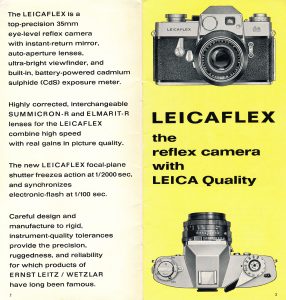
Even the electrical components received the Leitz treatment, with all circuit boards and wires permanently soldered in place by hand. This was in contrast to Japanese camera makers who often made electrical components modular so that they could be assembled or removed outside of the camera without having to desolder or resolder anything. This allowed for Japanese cameras to be built faster and cheaper, and allow for minor mid-model changes and improvements to the original design, without having to completely redesign other parts of the camera. With the Leicaflex, everything worked in harmony and unison, and to change one part meant changing many others.
The camera was designed as a fully integrated system that could only be assembled or repaired by highly trained technicians who understood each component and could make the required adjustments for smooth and reliable operation.
Upon it’s release in 1964, the initial reaction from the photographic press was of disappointment. When it was first released, the Leica M3 shocked the world with many firsts in rangefinder design. Featuring a unique and intuitive layout that has remained popular among rangefinder shooters for the next several decades. Many people expected to be wowed by the new Leitz SLR, but upon seeing it’s lack of TTL metering, non removable prism, and lack of motor drive support, the camera was seen as obsolete compared to increasing Japanese competition and innovation.
To it’s credit, the Leicaflex was beautifully made and inherited the engineering excellence of the Leica M3 that preceded it. It had the brightest viewfinder of any SLR camera on the market, and although it’s lens selection was limited, the four Leica R-mount lenses that were available were SLR versions of the same excellent 35mm, 50mm, 90mm, and 135mm lenses available for the Leica M3.
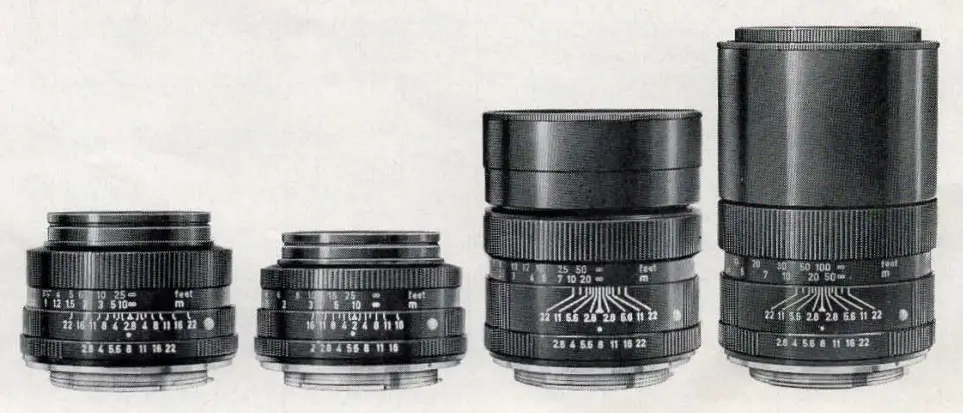
Despite being built to the same standards that people accepted of a Leica, it was not accepted by professional photographers and because of it’s extremely high price, sold very slowly.
When it went on sale, the Leicaflex sold with the 50mm f/2 Summicron-R lens for $585, which when adjusted for inflation compares to $4850 today, an astronomical price for a brand new SLR without features available on other cameras costing far less.
With the shock of disappointment out of the way, within the camera’s release, the perception of the Leicaflex began to improve as people began to appreciate the clean and purposeful design of the camera and it’s controls. What the Leicaflex lacked in “wow factor” it exuded with smoothness and precision. It seemed the Leicaflex appealed to the same kinds of photographers who still clamored for the Leica M3 (and soon to be released M4), none of which had TTL metering or automation of any kind.
The following two articles are both from the April 1965 issues of Camera 35 and Popular Photography and give a very fair look at what was still a very expensive, but excellent camera.
By far, the biggest criticism of the Leicaflex was the lack of TTL metering, but an absence of professional features like a motor drive coupling and interchangeable viewfinders were also things that pro photographers had come to expect and Leitz obviously was listening as at various points, they attempted to incorporate all three.
The most widely known was the Leicaflex SL and SL2 from 1968 and 1974 which added a through the lens meter, and also updated the lens mount, but there were also a short number of motor drive equipped cameras known as the SL Mot and SL2 Mot that worked with a large Leicaflex Motordrive that was as big as the camera itself.

The least well known upgrade was a prototype Leicaflex with interchangeable viewfinders which never made it into production. Only three interchangeable viewfinder Leicaflex bodies were produced, which could accept a standard pentaprism, waist level, and magnified viewfinder. The camera was likely developed at the same time as the original Leicaflex as the serial number seen on the lens in the prototype picture to the lens is a “pre-series” number. I could not find any information about why this feature was never included, but my best guess is Leitz wanted to prioritize a metered body over one with interchangeable viewfinders, and other than the Topcon RE Super, no other camera had both an in body exposure meter with interchangeable viewfinders.
Edit 8/22/2020: After posting this article, I was told by another collector that the reason Leitz scrapped the interchangeable viewfinder was due to a lack of being able to perfectly keep out dust.
In the years that would follow it’s release, the Leicaflex was just successful enough to encourage Leitz to keep making them, but it was said that by the release of the SL2 model, the company was losing money on every body sold, and with rangefinder sales continuing to decline, the company would need to make a pretty bold move if they wanted to stay in business.
That bold move came in 1972 when Leitz partnered with Minolta to help them produce a compact rangefinder using the Leica M3’s lens mount, but in a more compact camera that could be sold for less. It was thought that this new Leica/Minolta hybrid camera would benefit both companies by giving Leitz access to Minolta’s larger and more efficient production capacity, and Minolta by giving them a leg up in the premium rangefinder market.
The resulting Leica CL and Minolta CL were released in April and November 1973 respectively to a positive reception, but it wasn’t until the second collaboration between the two companies that Leitz would truly see success.
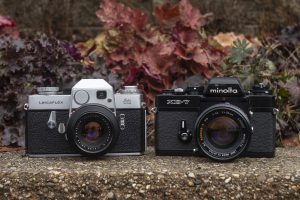
In 1974, the same year as the debut of the Leicaflex SL2, Minolta would debut the XE/XE-1/XE-7, an advanced SLR that was a step down from the company’s top of the line XK. The XE-7 would have state of the art features for the time and had an excellent built quality. Most importantly, Minolta was able to mass produce them and sell them for a profit. The two companies would work together, and in 1976, Leitz would release their version of the XE called the Leica R3. The camera used the body and shutter of the Minolta camera, but had it’s own lens mount, lenses, and an all new metering system. The R3 would be the first in a long series of Leica R SLRs all based on Minolta bodies that would be in production until 1997 when an all new camera called the R8 would make it’s debut.
Despite sharing some Japanese DNA with Minolta, the Leica R3 through R7 were enormously successful for the brand and have been credited as keeping the company in business through the 1980s and 1990s. Leitz would continue to update their Leica M rangefinders, but it was their SLRs that produced the highest profits.
Today, like pretty much everything with the Leica name on it, the original Leicaflex is sought after by collectors because of it’s high build quality and excellent lenses. This is a camera that can still easily be used today to make excellent photographs, so it appeals to both collectors and users alike.
My Thoughts
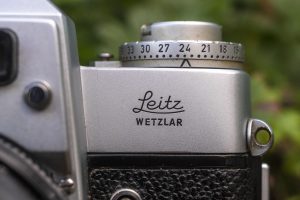
There’s two kinds of Leicaflex people out there, people who have one and people who don’t. As a member of the “people who don’t” crowd, I was guilty of having the opinion of Leitz as being a rangefinder company. Sure, I knew they also made SLRs and that they were probably good cameras, but I guess I never really took their attempts at anything other than rangefinders all that seriously, so when my friend and fellow collector Paul Rybolt asked me if I wanted to borrow his Leicaflex, I figured, sure why not.
When I picked up the camera from Paul at the Ohio Camera Collector’s Society’s show last September, I immediately could tell that perhaps there was a little more to the Leicaflex than a half hearted attempt by a rangefinder company to make an SLR.
For starters, the Leicaflex is heavy. With the Summicron-R lens mounted, the camera weighs in at 1144 grams (2.52 lbs) which puts it into Nikkormat FTn territory. It was clear that Leitz did not take any shortcuts in the build quality of the lens.
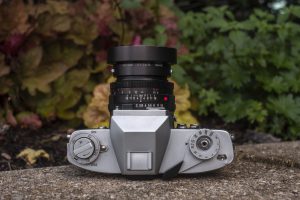
On top of the camera, from left to right is the combined rewind knob with flip out handle, film reminder dial, and ASA/DIN film speed dials. The numbers for the various film speeds are written on the side of the dial and can’t be seen looking down upon the top of the camera, but this is where you calibrate the meter for whatever film you have loaded.
The top of the prism has an accessory cold shoe, and to the right is the film advance lever, combined shutter speed dial and cable threaded shutter release, and automatic resetting exposure counter.
Leitz designed the shutter speed dial similarly to the one on the Leica M5 and Canon EF in which the leading edge of the dial ever so slightly hangs over the front edge of the camera, making it incredibly easy to change with your right index finger with the camera to your eye. This is a feature that I absolutely love and wish more companies would have implemented.
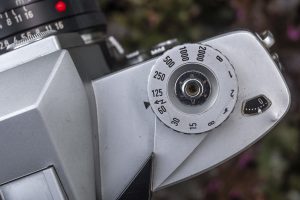
The film advance lever has a long throw, but is incredibly smooth in operation. Pulling the lever away from it’s resting position, the first 45 degrees or so doesn’t actually do anything. You must first pull the lever into what the user manual refers to as the “ready position”, before continuing to push it throughout the rest of it’s motion to advance the film and set the shutter. In use, this allows for a very quick and smooth operation, but is detrimental to left eye shooters as the ready position of this lever points almost straight back from the camera body, directly into your forehead. This is a complaint I’ve heard about Nikon SLRs as they also have a second ready position, but it doesn’t stick out nearly as far as the Leicaflex’s. Personally, I didn’t find this to be all that objectionable, but I could definitely see how some users might hate it.
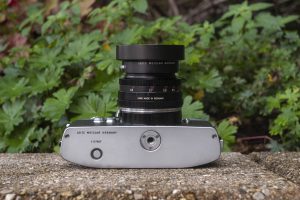
The bottom of the camera features the rewind release button and centrally located 1/4″ tripod socket. As you might expect from a precision Leitz product, the tripod socket is reinforced with three screws and is part of the main chassis of the camera for increased strength.
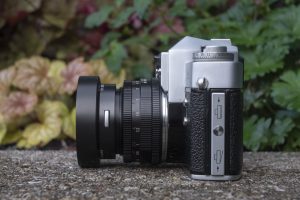
The left side of the camera has the release for the film door. The design of the lock is a different than others, in that you must press in on a circular button in the middle while sliding the entire rectangle up to unlock the door, and down to lock it.
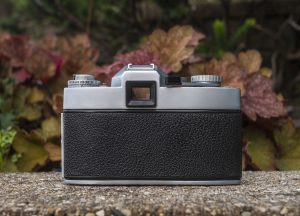
The back of the camera only features the rectangular opening for the viewfinder. The body covering of the camera is typical of other 1960s SLRs, but seems to have held up well over the years with no peeling or cracks.
Notice the numbers on the side of the ASA/DIN film speed dial that I referred to on the camera’s top plate.

The film compartment is thoughtfully designed like you’d expect from other quality SLRs. Featuring a left to right film transport onto a fixed takeup spool, there are twin polished film rails, an extra large and smooth film pressure plate, film rollers, and an arrow engraved into the spool to indicate the direction in which the film winds onto the spool. The Leicaflex uses felt light seals that have not degraded and did not need replacing like other cameras of the era.
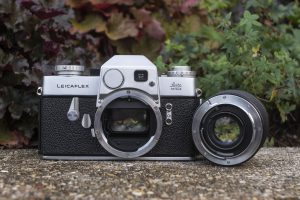
Up front, the Leicaflex is unusually busy, with a body mounted self timer and mirror lockup lever to the left of the lens mount. Immediately below the mirror lockup lever is the lens release for the Leica R bayonet lens mount. As was the case with any new SLR, the Leicaflex required all new lenses and was not compatible with Leica’s M-mount lenses from the M3 due to the increase depth required for the mirror box in an SLR. Luckily, upon the camera’s release, Leitz was able to adapt many of the same excellent lenses they used to work with the new mount.
To the right of the lens mount are twin ports for electronic and flashbulb sync.
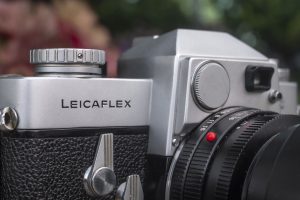
On the front of the pentaprism is what was likely the most controversial feature of the camera, it’s body mounted CdS meter. When the Leicaflex was in development, Through the Lens or TTL metering was still in it’s infancy. Many manufacturers like Nikon, Minolta, and Canon did not yet have in body TTL meters, so the Leicaflex contains not only a small rectangular window for the meter, but a circular compartment for the PX625 battery, and a battery test button. While it doesn’t have a negative effect on the camera’s operation, having the battery compartment in such a front and center location is very odd as most companies put them either on the bottom or back of the camera.
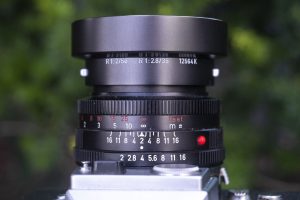
This Leicaflex came with the Summicron-R which has a very nice feel with positive click stops at each aperture from f/2 to f/16 and a nicely dampened focus wheel. The lens is seen here with an original Leitz lens hood.
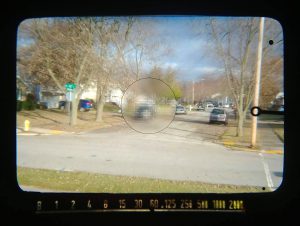
So far in this review, everything I’ve mentioned suggests the Leicaflex was a high quality camera, made to exacting standards. The ergonomics of the camera are very good, and it has a nice amount of heft in your hands. But, nothing yet has had any “wow factor” that you couldn’t get from another high quality SLR of the same era. Not until you put the camera to your eye that is.
The viewfinder on the Leicaflex is simply stunning. Without a doubt, this is the brightest and most evenly lit viewfinder I have ever seen which is all the more impressive that this is in a camera from the 1960s. Leitz simply refers to the focusing screen as the “ultra bright viewfinder” but whatever technology was used to make it was way ahead of what other German or Japanese makers were doing or would do in the decades to come. It’s worth nothing that as viewfinders got more complex, they often used liquid crystal overlays to show focus confirmation and other things, which actually make modern SLRs darker than older cameras.
Edit 8/18/2020: After posting this article, a few people pointed out something that I completely missed while shooting the Leicaflex, which is that the entirety of the viewfinder can’t be used for precision focusing, only the center. By omitting the necessary ground glass needed to precisely focus all the way to the corners, Leitz was able to achieve such a bright viewfinder. Other companies like Zeiss-Ikon employed a similar method to improve viewfinder brightness like on the Contaflex, but somehow I missed this. Nevertheless, it didn’t impair my ability to correctly focus every image I shot with it.
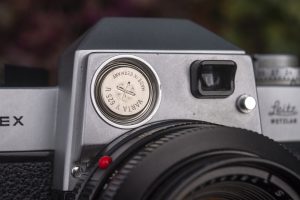
The viewfinder shows a row of all available shutter speeds across the bottom, just like a Nikkormat FT, and the right side shows the match needle which works similarly to how all match needles work. There is is only a central microprism with no split image focusing aide, which on another camera might be a little bit of a disappointment, but with the incredibly bright viewfinder, seeing a sharp image through the hundreds of tiny little prisms is very easy. I did not struggle at all with focus like I do on some other SLRs of the era, even in dim light.
Many people consider the viewfinder in the Leica M3 to be one of the best in any rangefinder ever made, and it’s interesting that they managed the same feat with the Leicaflex’s. If there was one “wow” feature of using this camera, it’s not the excellent build quality, the ultra-smooth film advance, or the incredibly sharp Summicron-R lens, it’s that viewfinder.
My Results
As I often do with most loaners, I loaded back to back rolls of film in the Leicaflex. Normally I try to use two different kinds of films to give a better idea of how the camera might perform in black and white or color, or with films with different speeds. Apparently I had a ‘brain-fart’ and ended up loading two rolls of Kodak Portra 160NC which happens to be one of my favorite color films, but in hindsight, I wish I had paid closer attention to what I had for the first roll and selected something different for the second.
Even before anyone ever saw the first Leica SLR, I don’t think anyone doubted Leitz’s ability to produce a world class camera, and that’s exactly what they did. The Leicaflex was an expensive precision tool that was designed in a way in which no expense was spared to deliver the highest quality results possible, so it’s no surprise to see outstanding images from one.
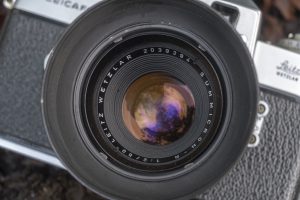
The typically muted colors of Kodak Portra 160NC are a perfect match for the Summicron-R lens. In fact, these might be the best results I’ve ever seen from this film as the colors have a natural warmth that when shot through a lesser camera, would come off as artificially yellow. People who are better at lens reviews than I would likely say things like pleasant tonality and good rendering, but to my eyes, I’d just say they look great.
The most notable comment I can make about shooting with the Leicaflex is how smooth and effortless the camera is. I have no idea of this particular camera’s history in the decades before it made it’s way to me, but I don’t have any reason to believe it’s been serviced any time recently. Based on various other reviews of this camera saying basically the same thing, I just have to believe that all the additional effort put into creating this camera is why they’re all so nice to use.
I really like the Leicaflex, but it’s not perfect. The most glaring omission in the camera’s feature set was a through the lens meter which was likely a tough pill to swallow for potential customers when this camera was first released but today isn’t as big of a deal as you might think. In use, I found the metering to be accurate enough for the general purpose images I shot. The match needle system works as well as any other I’ve used and not once did I ever think “boy I wish the meter was inside of the camera”.
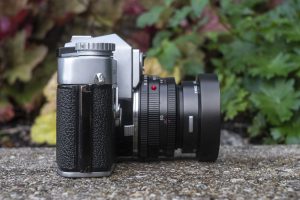
My nitpicks of the Leicaflex are pretty minor, but at 1144 grams with the Summicron-R lens mounted, the camera is very heavy and would likely cause fatigue if left hanging around a photographer’s neck for long periods of time. I also question the logic of having the film advance lever stick nearly straight back in it’s “ready” position. Sure, the film advance lever is one of the smoothest I’ve ever used, and can be flung with your thumb very quickly, but as a left eye shooter, it was constantly poking me in the forehead each time I wanted to wind the camera. If you don’t like Nikon SLRs because of how the lever sticks out, you’re going to hate the Leicaflex.
But other than those two minor quibbles, there is a lot to like about the Leicaflex. The camera is smooth, the viewfinder is amazing, and I lovelovelove the shutter speed dial that overhangs the front plate. Later Leica SLRs might have added TTL metering and other modern conveniences, but it’s nice to see how good of a job Leitz did on their first attempt, despite being known only as a rangefinder company.
My recommendation of whether you should seek out a Leicaflex for your collection depends largely on your budget. If you’re patient, you can sometimes find Leicaflex bodies in untested condition for under $100, but the lenses are expensive so to find a body and lens together, be prepared to spend quite a pretty penny. A quick eBay search for sold Leicaflexes with the Summicron-R vary from $275 to well over $500, which compared to an M3 is nothing, but for budget minded collectors like myself, it’s steep.
If you do make the decision however, it’s unlikely you’ll be disappointed. These were fantastic cameras that deliver fantastic results. Highly recommended!
Related Posts You Might Enjoy
External Links
http://camera-wiki.org/wiki/Leicaflex
https://en.wikipedia.org/wiki/Leicaflex_/SL/_SL2
https://web.archive.org/web/20070826193938/http://www.ozdoba.net/leica/reflex_hist_e.html
http://rlfc.world.coocan.jp/PlaywBody/R_Body/LeicaflexMkI/LeicaflexMkI.html (in Japanese)
https://www.l-camera-forum.com/leica-wiki.en/index.php/Leicaflex_Mark_1_and_Mark_2

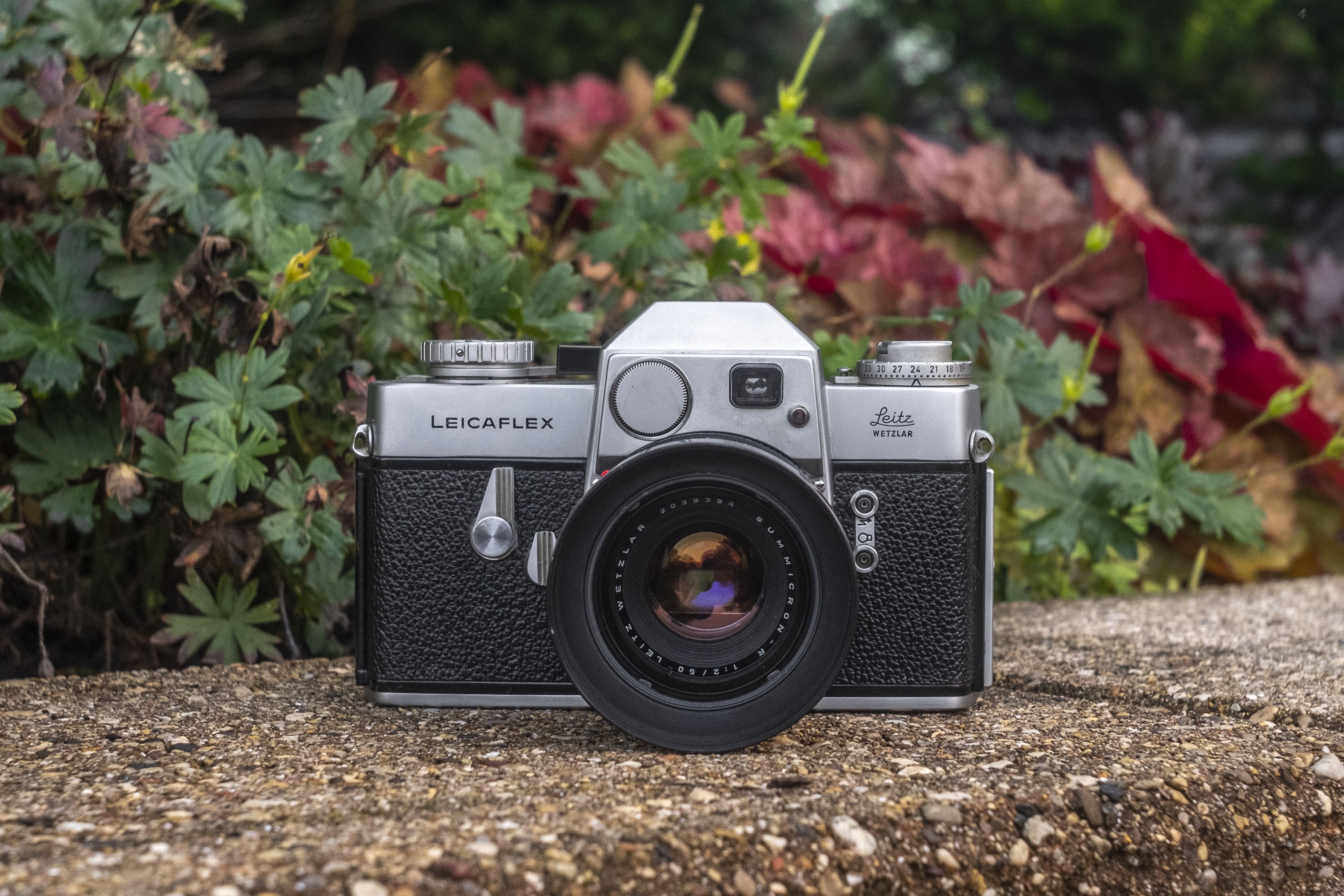
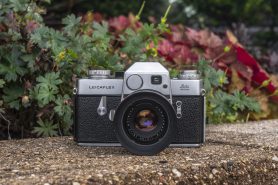
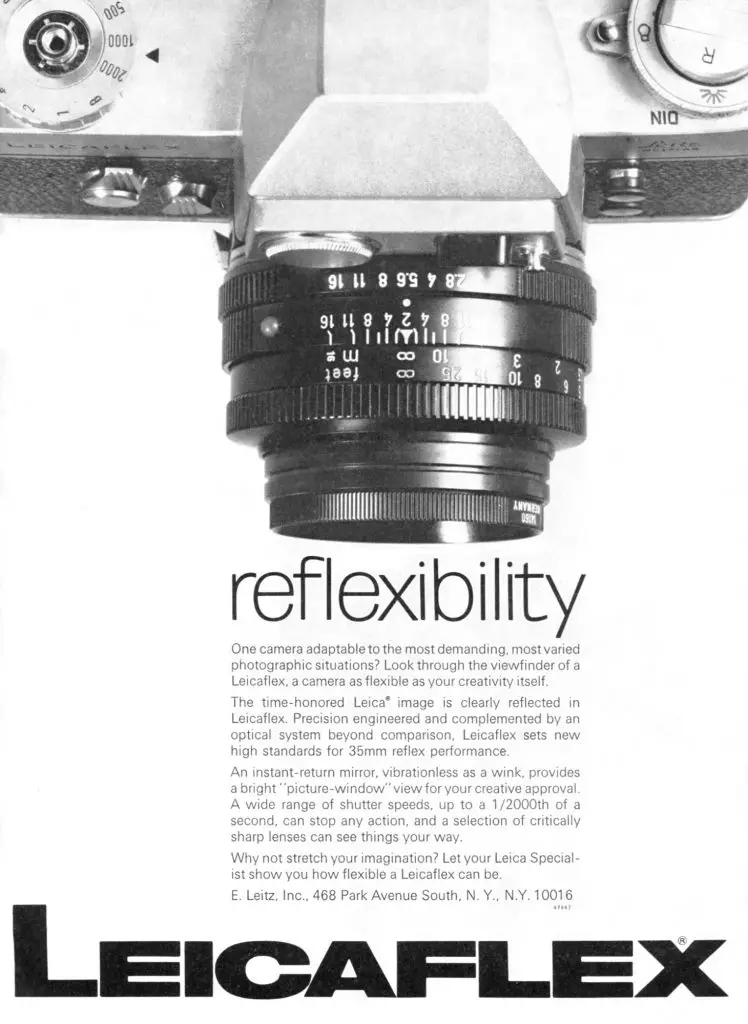
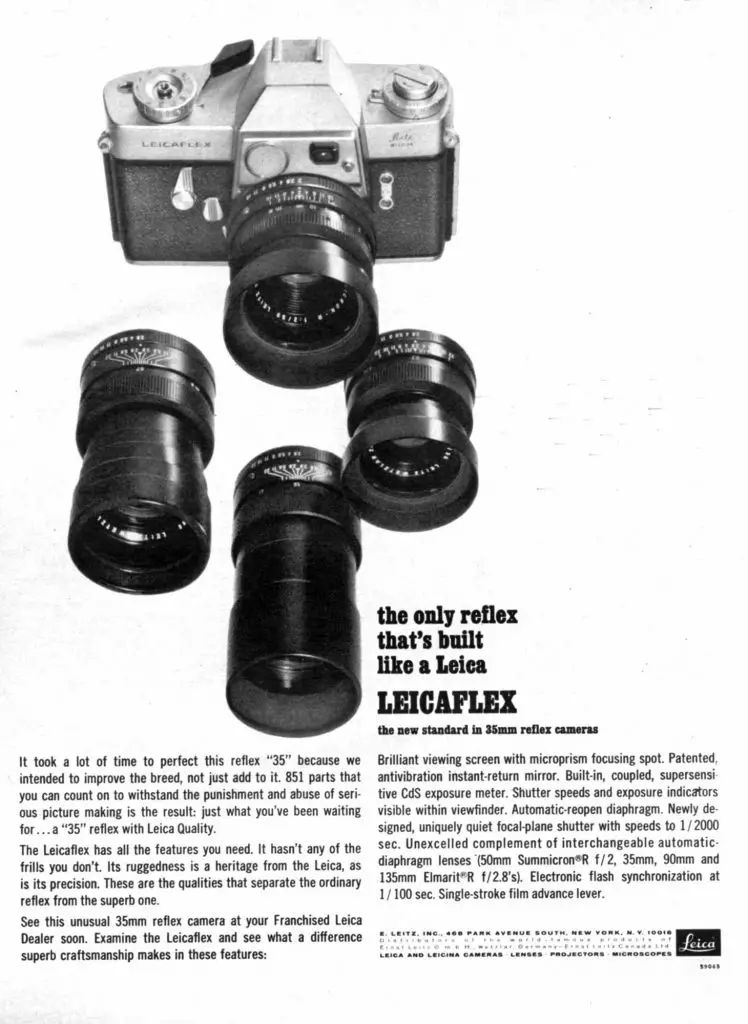
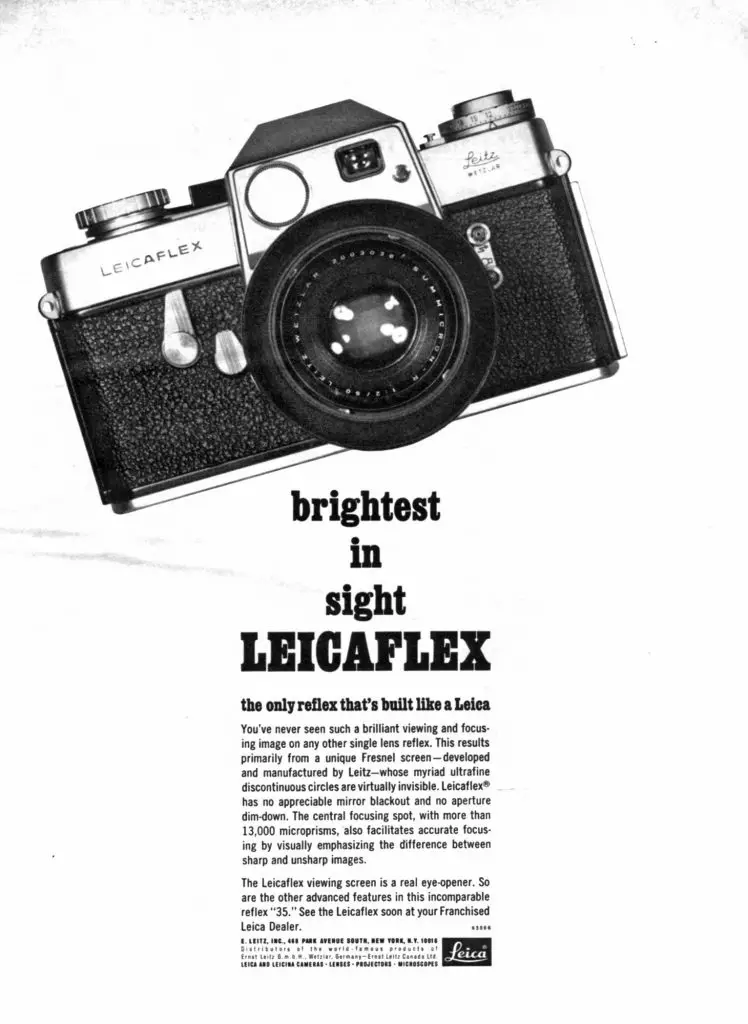
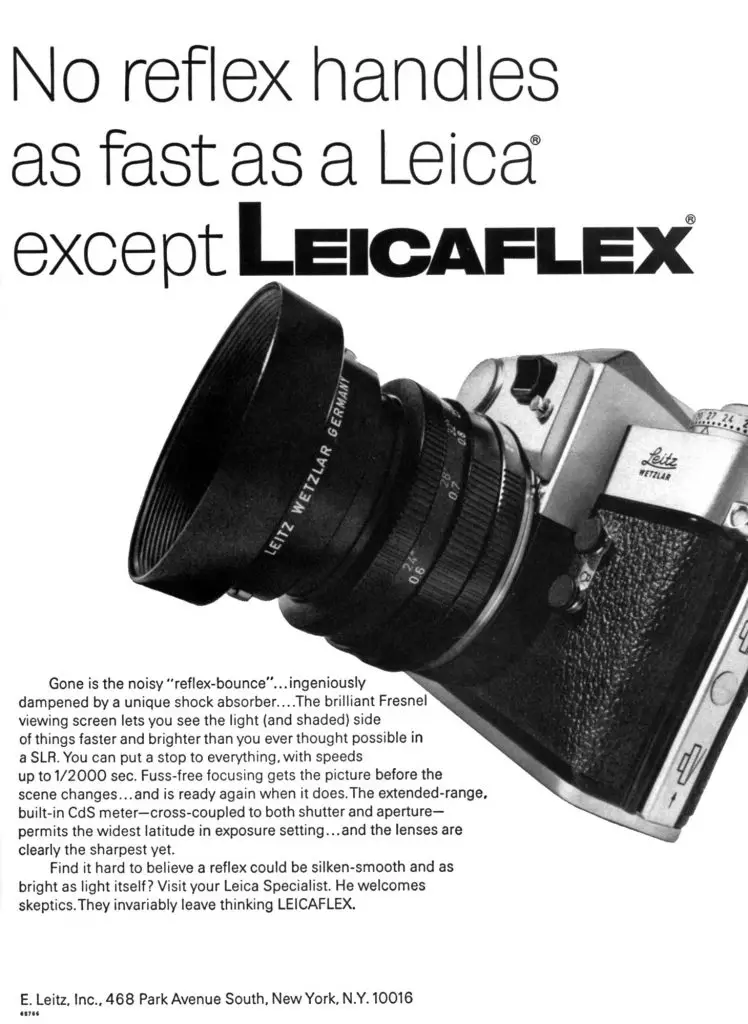
















Mike, I’m not surprised that you warmed to the Leicaflex. Leica was a camera that most yearned for, but couldn’t afford. I was 19 years old when the Leicaflex was launched and can even now remember all the initial excitement it aroused. Later, around 1980, I did buy an excellent used sample of the first model, and loved it. Still do. It has not been serviced for me, but still runs as smooth and quiet as the day I got it. I took a gamble on the f2/50 Summicron that came with it as there was some corrosion evident on a couple of the iris blades, bit it hasn’t developed any further and the blades are still snappy.
The R lenses have added contrast that was becoming popular by then, and they have a natural sharpness, unlike modern lenses which can sometimes appear overly sharp.
If I may, I’d like to add a couple of comments. Firstly, I read contemporaneous views about the reason Leitz eschewed an interchangeable v/f, and these were based on their concerns about the integrity of the v/f re a dust free environment for the shutter box/assembly or for the body itself. Secondly, what may seem a minor point, there’s no fiddling around for a coin to unscrew the battery compartment cover!
Great overview Mike. I accidentally found my way into Leicaflex when I bought a couple of lenses at a local estate auction (50 summicron-r and 90 elmarit-r single cam).
Multiple lenses and Leicaflex bodies later, I wonder why I am keeping my Leica M5 because the size is not much different, and I find the ergonomics as good if not better. It is way easier to find excellent condition Leicaflexes and lenses which have not been beaten to death than it is Leica M bodies and lenses.
Leicaflex is not a replacement for other lighter cameras -it’s definitely a beast. I don’t think you’d want it as your only camera. But who reading this has only one camera really?
Interesting enough, Mike, to set off the inevitable GAS attack. For years I’ve thought about buying one of these with the Summicron … or a Contarex with the Planar. The Leicaflex appears a wiser and more practical choice. And for a guy who thinks a Nikon F2 is just the right size and weight, the Leicaflex would be a pleasure to shoot. BTW, How do you manage to get such dynamite pictures thru camera viewfinders?
What a gorgeous piece of uber-Teutonic engineering and craftsmanship. Now you have raised the GAS and I would like to try one. I can’t say that a Leicaflex would do anything to improve my photography or achieve anything that I cannot do with the 35mm cameras that I already have, but it would be fun. Unfortunately, repair and CLA on these machines is pretty costly in USA.
Hi, Andrew. I’m sure you are correct. If it’s a question of I’d like one, rather than I need one, the initial outlay in getting a decent one and the potential cost of a CLA can certainly give the “sensible” part of our brain food for thought. But then had I listened to the sensible me I’d not be enjoying a mint Contax 1 or Contarex Super. I don’t use them other than to play with them, but I still derive a lot of pleasure just handling them and the pride of ownership of a couple of cameras I could only dream about years ago.
Responding to both Andrew and Terry. I’ve received some really strong feedback on the Leicaflex after posting this review. Many agreeing with my praise for the quality and smoothness of the camera, others flat out chastising how much of a complete failure and disappointment it was. Nearly all of the strong negative reactions I’ve encountered are from people who I question whether they’ve actually used one as they all have the same complaints over and over about missing features like TTL metering and other things.
Whenever I write these reviews, it’s easy when someone disagrees with you to question yourself and think, “Gee, maybe I missed something”, but in this case, I still 100% support my initial reaction that the Leicaflex is a spectacular camera. Yeah, it’s expensive, but no worse than any other premium camera from the 20th century. And yeah, they can be hard to fix if something goes wrong, but if my small sample size is any indication, having now shot two of these that both worked wonderfully, your odds of getting a good Leicaflex are still much higher than that of cameras like the Zeiss Contarex or a Retina Reflex.
The negative comments: the photography world seems to be full of douche-heads who think they know everything about photography and have a compulsion to spout their “expertise” whenever they can. And just as you wrote, many likely never even touched the item that they are condemning. The worst were the digital button-pushers a few years ago who said they hated film. Well, that is the brave new Internet world.
Back to the Leicaflex, I’ll keep my eyes open for a nice one; maybe emotion will overcome frugality (i.e., the “sensible” part of my brain, which is lacking)……
Mike, I’m with you all the way. I, too, wonder just how many today have handled a fully working example? When the Leicaflex finally hit the shops in the UK it was greeted with some disappointment in that it didn’t meet with high expectations that many had for it. This was because they were expecting a camera to fully compete with the Japanese pro’ cameras of the era. So it didn’t come with TTL or an interchangeable v/f, so what? Leica never did bow to pressure for an interchangeable v/f in any subsequent slr, screens yes in the R4 onwards, but the next model, the SL did provide TTL metering and this resulted in the superb SL2, said by many to be possibly the best manual slr of all.
But I believe that the detractors overlooked what the Leicaflex was, and that it came from a company that ploughed its own furrow. It wasn’t into mass production and was therefore very unlikely to be able to compete with the established market leaders for pro’ cameras. So they produced what they knew how to, a very high quality camera following in the tradition of their M series, but an slr, and with very high quality optics for the era. Then there is that v/f that you so love.
Handling one today, one can see where the money went, a superb piece of craftsmanship, and at the risk of upsetting some Nikon fans, it leaves the Nikon F in its wake for build quality. And lest anyone should question this comment, I also have an excellent and fully working black Photomic Ftn for comparison.
Well, Brian says: ‘I don’t think you would want it as your only camera.’ I bought a Leicaflex for £60 on an eBay auction three years ago. I’ve subsequently purchased 35/2.8, 50/2, 90/2.8, and 135/2.8, the four lenses they were introduced with. A few months ago I got a second body for £75, my bodies are 1967 and 1965 respectively. As my meters do not work, the cams issue does not affect me. I use a pair of handheld meters, a Weston Master V for reflection and a Sekonic Studio Deluxe for incident metering. Both are non- battery powered. I usually take the 35 & 90 lenses with the 35 mounted as that’s the one I use 90% of the time. I don’t use zooms as they are too slow and cumbersome. I mainly use Tri-X and sometimes Ektar 100 colour print. As I have my negs scanned to disc, my two Leicaflex cameras are digital cameras. Imagine that, me, a digital Johnny? Yes, the outfit is heavy. I carry my stuff in a Billingham 335 my boyfriend bought me 21 years ago at Christmas. I’ve noticed people looking at my Leicaflex but nobody has mentioned it yet. The earlier lenses used the series system for filters: 35 & 50 series VI, 90 & 135 series VII and the shift lens 35 f4 Schneider Kreuznach P A Curtagon takes series VIII filters. I’ve got a couple of VII for mono with the 90. I bought my 35 and 90 from Germany and have been using a dictionary to translate to English. After all, I didn’t want to buy a lens with fungus. I’ve now bought Das Leicaflex Buch- The Leicaflex Book by Theo Kisselbach, it’s in German so is helping me learn the language. Did you know that Rot is German for Red.? (Filters. ) I can recommend the Leica R Compendium by Jonathan Eastland. The detailed information regarding lenses is absolutely invaluable. I’m considering buying more lenses for my Leicaflex cameras and this book is my first port of call. I’ve sold off my Nikon F/F2 gear and much prefer the German stuff. Naturally, I have a Mercedes Benz car, a GLE model and like Hugo Boss clothes and Mont-Blanc pens and pencils. Apart from the defunct meters (and the correct battery hasn’t been available for 30 years? ) everything works fine on my bodies.
No one has mentioned the mercury oxide cell PX 625. This has not been available for 30-40?years at least. Banned by EU, USA/Canada etc. of course Blighty jumped on the bandwagon. Users of the Photomic heads for the Nikon F, the Canon F1and F1n plus Nikkormat up to FTN and Olympus OM1 find that the Alkaline PX625a which gives 1.55v makes their meters inaccurate. Ditto the Leicaflex trio. There is the Weincell. 1.35v. However, it’s about three times the price of the PX625a, and in use lasts 2-3 months before failing and emitting a corrosive goo. Workarounds? Well: estimate, use a handheld meter. That’s what I do with my Leicaflex and pair of M3 bodies. I recommend the Gossen Lunalites. They run on the readily available PP3 9v batteries available in most countries I’ve visited. Even available in my rural English village shop! The meter uses three LEDs for readout rather than a galvanometer needle that could be knocked off its pivot by shock.
It allows reflective and incidental readings so combined you have a higher standard of metering. My favourite lens for the original Leicaflex (mine dates to 1964) is the Schneider Kreuznach P A Curtagon 35mm f4. This takes series VIII filters in the lens hood, but the lens has a filter thread of E60. Thus with a 60-62mm step up ring, the readily available 62mm filters can be accommodated. A simple 62mm lens hood can be attached to the filter. The lens is not connected to the metering system and focus/framing has the be done at f4 before stopping down. This equipment is seriously heavy, but there’s a lot to be said about a one lens outfit – see Dan Milnor’s thoughts on this approach.
Great info, thanks David! 🙂
Mike,
In 1964-65 my neighbor Milton Frier, who worked for NY Leitz, loaned me a null series prototype Leicaflex. I was the yearbook photographer of Gorton high school in Yonkers, NY. I was shooting 20 rolls of plus-x a week, all developed in Rodinal. So Milt said:” use the hell out of it”. Boy I did; in those days my camera was the cheapest, Asahi Pentax H1a w/ 55/2 Super Takumar. So no meter, I used assortment of selenium & CDS meters. The Leicaflex standard took great photos, but much heavier than Pentax H1a. Because I only received a 50mm 1 cam lens, I used both camera,s. The Leica Summicron 50/2 was a joy. Negatives in b&w I printed on a Leitz enlarger. Printed and dried, it was sometimes hard to see, which camera, shot which? I enjoyed the four month experience, so much!